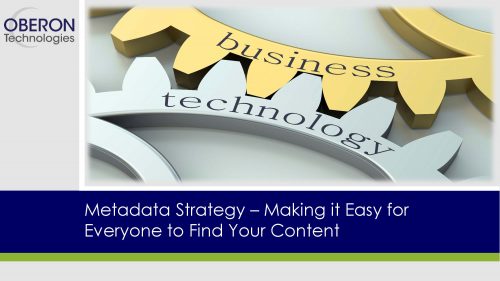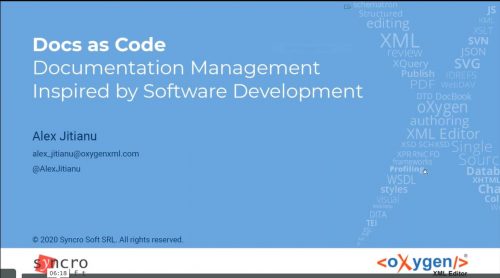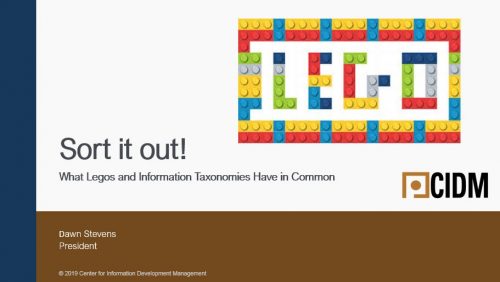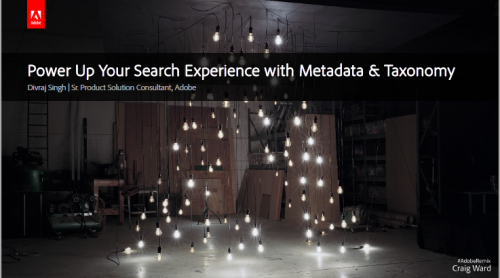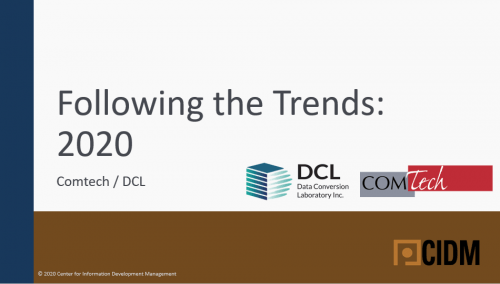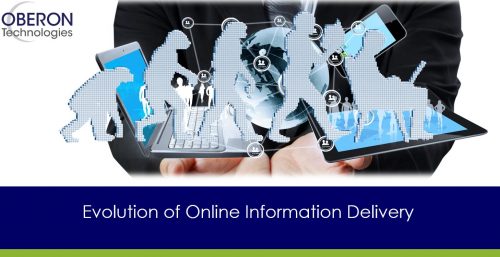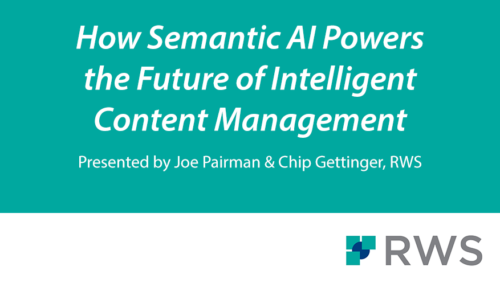-
September 17, 2019 When your users can’t easily find your information online, they may turn to the competition. When your writers can’t find the content they need, they will recreate it. And, when your organization doesn’t have a common strategy to identifying information across the enterprise you are wasting valuable resources as they search to find needed information. Whether in document properties, a keyword spreadsheet or within your content management systems, metadata is a key to findability. Learn how a metadata strategy adopted by all the content creators can make it easier for everyone inside and outside your organization to find the information they need. Presented by: Todd Burdin is a senior solution architect and strategic business consultant with 25+ years of software development and business consulting expertise, encompassing the entire content development lifecycle. He has extensive experience delivering innovative enterprise solutions for content management, structured authoring, and publishing to a diverse set of industries, including equipment manufacturers, pharmaceuticals, legal mediations, hospitals, and financials. Todd has worked at Oberon Technologies for 6+ years. Previous employers include PTC, Arbortext, Entrusted Solutions, and First Consulting Group.
-
April 1, 2020 Implementing DITA with a small team of technical writers does not have to be expensive or difficult to set up. We'll go through the steps of implementing a DITA solution using GitHub for storage and workflow and Oxygen XML Editor for editing. We'll also look into how you can automate publishing and receive feedback from your end users. As a practical example we'll look into how editing, collaboration and publishing on the Oxygen XML Blog works. Presented by: Radu Coravu started working more than 10 years ago as a software developer for Syncro Soft SRL, the manufacturer of the popular oXygen XML Editor. During the last years, his main focus has been in the development of the visual XML Author editing environment and the specific-DITA support provided by oXygen. He provides support for complex integrations and helps steer the product in the right direction, all this with some development on the side.
-
September 19, 2019 No matter where and how you author your content today – Word, InDesign, XHTML, Markdown, DITA, FrameMaker, and more – offering an immersive experience to your customers is the need of the hour. If you are still publishing your content as static PDFs only, you are depriving them of a rich and rewarding consumption experience full of unique possibilities. With the right digital experience solution, you can plug-in data insights to design, manage and deliver consistent, personalized and targeted content for every single customer. Join us in this webinar to see how an integrated solution can help you:
- Move from publishing static PDFs only to delivering immersive, fluid experiences throughout the customer journey
- Leverage next-generation capabilities like personalization, analytics, and targeting
- Still be able to publish to other popular formats at will – HTML5, Mobile Apps, EPUB, KINDLE and more
-
September 16, 2020 Tools and techniques used in software development can also be applied for documentation management:
- Storage and issue management using GitHub
- Automated quality checks and continuous publishing using Netlify
- Editing and collaboration support
- Release strategies
-
August 28, 2019 Looking for a single piece of content on a web site is often compared to digging in a giant bucket of LEGOs for a single unique piece – an often frustrating and futile endeavor. If those LEGOs are sorted by certain distinguishing attributes, such as color and size, the odds of finding a particular piece increase dramatically. As a result, companies often take a “LEGO-block” approach to their information taxonomies. However, the sorting of LEGO blocks is child’s play, compared to the intricacies of sorting technical content – the distinctions are not always as visible as color or size, and attributes that are that obvious may not be very useful in a search. Nevertheless, there are lessons we can learn from the “LEGO-block” approach. In this session, Dawn draws parallels between sorting LEGOs and sorting technical content, and provides suggestions for going deeper when the Lego model falls short. Presented by: Dawn Stevens is the President, and owner of Comtech Services and the Director of the Center for Information-Development Management. With over 25 years of experience, including 15 years at Comtech, Dawn has practical experience in virtually every role within a documentation and training department, including project management, instructional design, writing, editing, and multimedia programming. With both engineering and technical communication degrees, Dawn combines a solid technical foundation with strong writing and design skills to identify and remove the challenges her clients face in producing usable, technical information and training.
-
July 21, 2021 With this webinar, we are pleased to announce the release of the first-ever e-learning course to train technical writers and subject matter experts on the use of Simplified Technical English (STE), the global standard for writing clear and concise content. Most of the world’s leading companies have accelerated their digital transformation efforts during the pandemic—efforts that are not slowing down. Content plays a key role in digitalization, as it has an important impact on the customer experience, where good quality content will help grow and create new business and service models and ensure safe product use. Because of this key role, it is important that global writing teams learn how to write content that is accurate, clear, aligned, and easy to find by their customers. Through STE companies can maximize the value of their enterprise content, whether this is for technical documentation, marketing, or support. Technical writers will be able to further improve their skills and show industry credibility through an e-learning course, which one could do at any time and from any location. During this webinar, participants will learn more about STE, the values it brings, and how this e-learning course will help you create the best possible content. Presented by: Berry Braster has been in the technical documentation field for over 18 years and has helped implement content strategies, including the use of DITA and HyperSTE controlled language software. As Technology Director, Berry is involved with connecting technical documentation to IoT, and how to leverage on technologies like Augmented and Virtual Reality.
-
Date: October 2, 2019 Prior to DITA, there wasn’t much we could do when it came to strategizing with the rest of the enterprise and pooling our tools, processes, and content. That’s no longer the case; as we see more and more DITA adoption from many expected and unexpected divisions, from Training and Support to Academic Publishers, Operations and Insurance. A unified, DITA-driven, enterprise-wide approach to content can have a profound impact on the enterprise. When content created by the enterprise is treated as a valued and valuable corporate asset, it’s a win-win-win situation. It’s more efficient for the enterprise and easier for content creators. But end users reap the real benefit by getting the content they need when they need it. In this webinar, Bernard Aschwanden, will take you through 10 ways in which DITA can help drive unified content strategy. Presented by: Bernard solves documentation-based problems and helps companies generate more revenue. He guides clients through the best processes to create, manage, and deliver content. Once content is delivered, he helps socialize the message, understand and act on feedback, and improve the process and workflow. He is the founder of Publishing Smarter (www.publishingsmarter.com), an Associate Fellow of STC, and a Past President of STC. Bernard has helped hundreds of companies implement successful solutions. He is focused on publishing better, publishing faster, and publishing smarter.
-
May 13, 2020 There is an explosion of content today. But what makes your content stand out is – relevance and searchability. To ensure that customers don’t have to spend hours searching through your content, metadata is key. And to know what metadata to add while authoring, a well-established taxonomy is key. To design a truly best-in-class content search experience metadata and taxonomy need to work in tandem. In this webinar we will showcase:
- How to leverage metadata to make your content searchable
- What is the difference between good and bad taxonomies
- A live example of taxonomy development using Adobe Experience Manager
-
Date: July 11, 2019 Content needs to be delivered across multiple channels – printed documents, website, mobile app, chat bots, customer support website, IoT devices, and beyond – but needs to be relevant to end users in context of their search. However, end users struggle to find the right content easily as authors are always short of time to create content best suited for all these needs. Content needs to be served up on demand almost like a service which works no matter the device, channel and context in which it is viewed. It all comes down to structure. Find out how you can make your content ‘future ready’ by following some intelligent techniques. Key takeaways:
- How to make your content intelligent?
- How to make your content channel agnostic?
- How structured content can help achieve these objectives?
-
June 16, 2020 Unlike a decade ago, organizations face few barriers to entry if they want to develop structured content in a DITA-based ecosystem. The increasing adoption of Git as a content platform, and the maturing of DITA-focused products like oXygen have removed many of the cost barriers to implementing DITA in an elegant and scalable way. Whether a stop on a longer-term transition to a CCMS or the final destination, a mostly open-source DITA tool chain can be a valuable proving ground for a sophisticated content strategy. In this presentation, you’ll learn how process, information design, scalable repository design, and smart use of oXygen and Git can be more than a short-term solution. You will also learn where Git falls short and when you should be using a DITA CCMS. Presented by: Frank Miller president/ founder of Ryffine is an industry thought-leader whose career has focused on leading enterprise client engagements and building an information development community, Frank has been involved in dozens of successful DITA implementations. In addition to partnering with many leading names in the information development and content management spaces, Frank enjoys sharing his insights on trends and facilitating the adoption of best practices throughout the community. Presented by: Rik Page is EMEA Sales and Marketing Director at Bluestream Software and has been working with both component content and document management solutions since 200. During this time, he has worked with custom DTDs and Schemas, S1000D, iSpec2200 and since 2005 DITA. Rik's practical experience ranges from data capture/content creation through to dynamic multichannel delivery. This has been achieved in a wide range of industries including banking and finance, manufacturing, central government, and education. A keen advocate of technology and innovation Rik has taken part in multiple consultancy projects and helped formulate solutions all over the world.
-
Date: August 7, 2019 Gathering feedback from subject matter experts and other stakeholders is frequently a source of frustration for both content developers and SMEs alike. Whether you use the old “red pen” technique or circulate PDFs to your SMEs for comment and review, incorporating that feedback into your source content is time-consuming, labor-intensive, and error prone – not to mention difficult to track over time. In this webinar Chad Dybdahl, Adobe Solutions Consultant, will walk you through a highly collaborative workflow experience that allows you to:
- Easily collect feedback from many stakeholders simultaneously, in real-time
- Quickly import changes from reviewers back into your DITA source content
- Accept and reject whose changes
- Preserve trackability of the changes throughout the content lifecycle
-
May 12, 2020 In its eighth year of collecting data, the Center for Information-Development Management (CIDM) and Data Conversion Laboratory (DCL) asked managers, information architects, writers, training developers, and more how they are addressing the challenges of meeting customer information needs. During the webinar we walk through the results of the 2020 Trends Survey, a study we have been conducting since 2012. We trace the changes in how we think about developing and delivering content. Learn how others in the information-development community are planning to respond to new customer demands for innovative approaches to development and delivery. Presented by: Dawn Stevens, President, Comtech Services and Director of CIDM has 28 years of practical experience in virtually every role within a documentation and training department, including project management, instructional design, writing, editing, and multimedia programming. Dawn is the perfect advisor to identify and remove the challenges you face in producing usable, technical information and training content. With both engineering and technical communication degrees, Dawn combines her solid technical foundation with strong writing and design skills to lead our team of consultants and specialists in providing the expertise you need. Mark Gross, President, Data Conversion Laboratory, is a recognized authority on XML implementation and document conversion. Mark also serves as Project Executive, with overall responsibility for resource management and planning. Prior to joining DCL in 1981, Mark was with the consulting practice of Arthur Young & Co. Mark has a BS in Engineering from Columbia University and an MBA from New York University. He has also taught at the New York University Graduate School of Business, the New School, and Pace University. He is a frequent speaker on the topic of automated conversions to XML and SGML.
-
March 9, 2021 Ironically, the terms utilized to describe a vocabulary of words used to organize and catalog information within a content corpus often are used inconsistently or interchangeably. However, each term represents a point, on an increasing scale of complexity and resulting data richness and applicability. In this two-part webinar, Dawn Stevens of Comtech Services defines key points along this scale, comparing and contrasting the scope and domain to which each term applies, suggesting when each might be used, and recommending the processes for creating it. Dawn is joined by Rik Page of Bluestream, who will demonstrate real-life examples of each in use. Participants will gain clarity about the approach required to make content more accessible for their users. View part 2 of this webinar here. Presented by: Dawn Stevens is the President, and owner of Comtech Services and the Director of the Center for Information-Development Management. With over 25 years of experience, including 20 years at Comtech, Dawn has practical experience in virtually every role within a documentation and training department, including project management, instructional design, writing, editing, and multimedia programming. With both engineering and technical communication degrees, Dawn combines a solid technical foundation with strong writing and design skills to identify and remove the challenges her clients face in producing usable, technical information and training. Rik Page is Sales and Marketing Director at Bluestream Software and has been working with both component content and document management solutions since 2001. During this time, he has worked with custom DTDs and Schemas, S1000D, iSpec2200 and since 2005 DITA. His practical experience ranges from data capture/content creation through to dynamic multichannel delivery, achieved in a wide range of industries including banking and finance, manufacturing, central government and education. A keen advocate of technology and innovation Rik has taken part in multiple consultancy projects and helped formulate solutions all over the world. Away from the office Rik is a Scout Leader working with young people and helping them to develop new skills whilst having fun.
-
March 4, 2020 Technical documentation is rarely created by lone writers, so there is a constant need for collaboration. Collaboration can be with other writers or with people with other roles, usually referred to as subject matter experts, who may be part of your organization or external experts. In order to be successful, the collaboration needs to be enabled by integrating it as part of the usual processes or workflows each user performs. In this presentation, we will explore a few collaboration scenarios that show how to implement continuous improvement loops for published documentation, how to integrate documentation as part of the product development workflow, and how immediate collaboration can take place. Presented by: George Bina is one of the founders of Syncro Soft SRL, the company that develops oXygen XML suite of XML editing, authoring, development, publishing and collaboration tools. He has more than 20 years of experience in working with XML and related technologies, bringing many innovative ideas to reality and contributing to XML-related open-source projects. He presented at many XML, DITA, and technical communication conferences, giving passionate presentations and challenging the technological status quo, trying to get the audience to think outside the box, and re-imagine the future.
-
May 21, 2019 As technology advances so do consumer expectations for online information access. No longer do users want to rely on printed materials nor are we satisfied with views of lengthy PDFs online. Consumers, both inside and outside your organization, want to quickly find just the information they need from any device. With the emergence of many connected products, virtual and augment reality the online information demands can be staggering. Is your documentation system ready to take you into the future? Find out how many organizations are taking steps to delivering better information today and prepare their organization to more easily evolve with technology advances and consumer demands. Attendees will learn: 1) What does the evolution of online delivery include? 2) How structured content impacts your future delivery options? 3) Why you don’t have to wait to begin improving your users’ online delivery experiences? Presented by: Vi Kellersohn is the Chief Marketing Officer of Oberon Technologies. Vi leads the marketing efforts, manages strategic partnerships and supports key client projects. For over 20 years Vi has managed and executed all aspects of marketing for B2B technology organizations working in partnership with sales management to build awareness for value opportunities across the content lifecycle. Vi enjoys spending time with her extended family and golfing with her husband and two sons.
-
April 30, 2019 Consumers have more avenues than ever before to find the content they need. Are you trying to decipher how content trends are impacting your business? Do you need to respond to a rapidly changing digital marketplace? Join us to discover how changing content development and delivery requirements are affecting your business today. Learn how others in the information-development community are planning to respond to new customer demands for innovative approaches to development and delivery. In its seventh year of collecting data, the Center for Information-Development Management (CIDM) and Data Conversion Laboratory (DCL) asked managers, information architects, writers, training developers, and more how they are addressing the challenges of meeting customer information needs. During the webinar we walk through the results of the 2019 Trends Survey, a study we have been conducting since 2012. We trace the changes in how we think about developing and delivering content. Presented by: Dawn Stevens, President, Comtech Services and Director of CIDM has 28 years of practical experience in virtually every role within a documentation and training department, including project management, instructional design, writing, editing, and multimedia programming. Dawn is the perfect advisor to identify and remove the challenges you face in producing usable, technical information and training content. With both engineering and technical communication degrees, Dawn combines her solid technical foundation with strong writing and design skills to lead our team of consultants and specialists in providing the expertise you need. Mark Gross, President, Data Conversion Laboratory, is a recognized authority on XML implementation and document conversion. Mark also serves as Project Executive, with overall responsibility for resource management and planning. Prior to joining DCL in 1981, Mark was with the consulting practice of Arthur Young & Co. Mark has a BS in Engineering from Columbia University and an MBA from New York University. He has also taught at the New York University Graduate School of Business, the New School, and Pace University. He is a frequent speaker on the topic of automated conversions to XML and SGML.
-
September 9, 2020 This is a presentation that provides an intersection between content and design. It is a high-level practical guide to analyzing your content, deciding what you want to do with it, developing style naming conventions, and developing editorial style guides, design style guides, and style templates. Once you get to that stage, you can then consider how content management systems, automation, and xml might fit into your publishing processes. Presented by: Marie Gollentz is a Senior Solutions Consultant focusing on the European market. Prior to joining Typefi, she held a number of positions in the publishing industry in London, including at the publisher of Research Fortnight and the London School of Business and Finance. Marie holds a Masters degree in European Political Sciences from the Autonomous University of Barcelona and a Bachelor’s degree in Political Sciences from Sciences Po Strasbourg. She is trilingual in English, French and Spanish.
-
Date: June 12, 2019 Abstract: Ever since DITA was first used, the greatest obstacle to adoption has been usability. Whilst technical authors have been prepared to learn the intricacies of DITA, others in the content creation lifecycle have been more obstinate. Bluestream together with Simply XML will show how the extensible XDocs CCMS can be integrated with clear browser and desktop authoring environments to allow subject matter experts to create and collaborate on content without ever having to see a tag. Presented by: Rik Page is Sales and Marketing Director at Bluestream Software and has been working with both component content and document management solutions since 2001. During this time he has worked with custom DTDs and Schemas, S1000D, iSpec2200 and DITA. His experience covers a wide range of industries including education, banking and finance, manufacturing and healthcare. A keen advocate of technology and innovation Rik has taken part in multiple consultancy projects and helped formulate solutions all over the world. Over more than two decades, Doug Gorman commercialized the structured writing methodology known as Information Mapping. In the process he realized that XML(DITA) could be used beyond Technical Publication Departments to modernize the enterprise content supply chain. The authoring and repository tools, however, would need to be easy to use. XML would need to be utilized but hidden “under the covers.” Simply XML’s authoring tool, Content Mapper, is a Word Plug-in where the author sees a Word User Interface and the CMS uses DITA XML. Content Mapper is designed for organizations that understand the value of XML as the content architecture, but with many of the 1 Billion plus non-technical authors who use MS Word on a PC. Content Mapper is integrated with Bluestream’s XDocs CCMS to help organizations achieve better content for readers with the important efficiencies of content reuse, single source publishing, and other process improvements.
-
August 10, 2020 Content developers and managers worldwide are coming together to share ideas and inspire each other at ConVEx in September. When first announced, we said ConVEx is not an online simulation of an in-person conference, but an immersive experience designed from the ground up to use our e-resources in the best possible way to bring you a wealth of ideas and information to support your efforts in defining and executing a comprehensive content strategy. During this Webinar, Dawn Stevens explains what we mean by this statement and what you can expect and gain from this new event format. We'll discuss the event format, the technology we'll use, and highlight the many networking activities provided. By the end of the Webinar, you'll know why you should attend ConVEx — it's an opportunity to have a positive experience, converge with others in the industry, focus your attention on industry issues, and magnify your value to your organization. Presented by: Dawn Stevens, President, Comtech Services and Director of CIDM has 28 years of practical experience in virtually every role within a documentation and training department, including project management, instructional design, writing, editing, and multimedia programming. Dawn is the perfect advisor to identify and remove the challenges you face in producing usable, technical information and training content. With both engineering and technical communication degrees, Dawn combines her solid technical foundation with strong writing and design skills to lead our team of consultants and specialists in providing the expertise you need.
-
October 9, 2019 Delivering a cCMS solution on time and on budget is critical, but it’s important to recognize that the cCMS is only one part of a successful content lifecycle strategy. Making sure your content can be leveraged across the enterprise and your system will be able to support future initiatives requires a comprehensive and proven plan. Having led hundreds of successful content solution implementations, Oberon understands the differences in the tools, processes and environments that must be considered. While each cCMS implementation plan may be unique, shaped by the specific needs of a given company, there are many common steps to success that everyone should follow. Whether you are looking to adopt cCMS for the first time or you’ve been using one for years, there are ways to ensure your system is optimized for success. Attend this webinar and find out what your plan should include. Presented by: Vi Kellersohn is the Chief Marketing Officer of Oberon Technologies. Vi leads the marketing efforts, manages strategic partnerships and supports key client projects. For over 20 years Vi has managed and executed all aspects of marketing for B2B technology organizations working in partnership with sales management to build awareness for value opportunities across the content lifecycle. Vi enjoys spending time with her extended family and golfing with her husband and two sons.
-
October 20, 2021 Semantics add unique benefits for content, especially within organizations utilizing structured content. Whether content is for detailed product documentation, polished marketing materials, or accurate, insightful employee enablement, all audiences gain by quickly finding what they want. While improving findability is key, providing accurate information recommendations dramatically increases relevancy with minimal use of personal data. From pages to personal assistants, reuse metrics to insights, content that connects to core semantics—the real-world ideas and objects it refers to—becomes truly intelligent. But, of course, benefits like this don't come from just pushing a button—or can they? During this webinar, Joe and Chip will discuss that while machine learning is a good start, it may not give customers the full value, clarity, or futureproofing required. So we challenged ourselves to productize a semantic AI approach that drives a polished end-user experience—and also appeals to busy editorial teams who care about quality but need to beat deadlines. We'll also examine emerging best practices for the practical adoption of semantic AI within your organization. Learn how RWS built a layered solution for Tridion, combining it with the power of semantic AI. These innovations fuse a powerful partnership of Tridion for content management excellence with PoolParty for taxonomy management. The results provide content teams with the power, automation, and accuracy of modern semantics with human validation. Presented by: Chip Gettinger is VP Global Solutions Consulting at RWS, managing a team that works with customers in maximizing global content with RWS. He has experience working with customers to develop global content strategies, business ROI adoption drivers, change management, and technology adoption for component content management systems. He speaks and blogs about customer successes working closely with industry standards, partners, and customers in technology solutions and deployments. Joe Pairman is Senior Product Manager, Tridion Docs. By looking at customers' underlying needs, and recognizing technical opportunities, he has built truly innovative solutions with strategic value. Joe designed and led the development of a personalized guidance app that helped millions of users without requiring any of their data. He also integrated a knowledge model with granular structured content to automatically give data integrators a broad overview of their available implementation options and next actions. Most recently, Joe brings the power of his first B2B product love –Tridion Docs – to a whole new market and user sector of smart specialists who don't have time to learn structured authoring. Product work is more than just building features – it's bringing people together to shape vision, plans, and priorities across the whole software lifecycle, in a way that keeps the original value when the ground situation inevitably changes. Joe has learned to get things done with solid, secure, engineering without losing track of the path to greater customer value.
-
December 4, 2019 In this webinar, Bluestream will show how advanced integration with oXygen Author and Editor throughout the content lifecycle can greatly help everyone involved in creating content. From content creation, review, branching and merging, release management and delivery via Oxygen Chemistry and Oxygen WebHelp Bluestream will show what the future is bringing. Presented by: Nenad Furtula a Partner, and VP of Sales and Marketing at Bluestream Database Software. Nenad has been working with XML and bringing XML related products to market for over 15 years. Currently his primary professional interest lies in building and socializing a DITA-enabled component content management system called XDocs. Nenad holds a BBA from Capilano University and MSc (Computer Science) from Dalhousie University.
-
August 26, 2021 With the plethora of content available to users today, it’s often a wonder that they are able to find any relevant information to their queries. In fact, it’s the most common complaint Comtech hears when conducting user studies for our clients: “I can’t find what I’m looking for in a reasonable amount of time.” What can we as technical writers do to address that complaint? We hear a lot about taxonomies and metadata and their potential influence in making our content more findable. However, Google uses over 200 ranking factors in its search algorithm that go well beyond this basic categorization. Surprisingly, a significant number of these ranking factors fall clearly within the realm of a technical writer’s responsibilities. In this rapid fire webinar, Dawn presents dozens of proven and speculative factors that you as a technical writer can address to optimize your content for findability. Presented by: Dawn Stevens is the President, and owner of Comtech Services and the Director of the Center for Information-Development Management. With over 32 years of experience, including 20 years at Comtech, Dawn has practical experience in virtually every role within a documentation and training department, including project management, instructional design, writing, editing, and multimedia programming. With both engineering and technical communication degrees, Dawn combines a solid technical foundation with strong writing and design skills to identify and remove the challenges her clients face in producing usable, technical information and training.
-
April 6, 2021 Ironically, the terms used to describe a vocabulary of words that organize and catalog information within a content corpus are often used inconsistently or interchangeably. However, each term represents a point on an increasing scale of complexity and resulting data richness and applicability. Following Part 1 of this webinar in which Dawn Stevens of Comtech Services defined and compared these points along the taxonomy spectrum (view part 1 recording), Rik Page of Bluestream now demonstrates the technology and tools that enable you to define and manage your terms and relationships, as well as those that consume what you have defined. Participants will see practical, real-life applications of the taxonomical concepts previously presented. Click here to download the reading list referenced during this webinar. Presented by: Dawn Stevens is the President, and owner of Comtech Services and the Director of the Center for Information-Development Management. With over 25 years of experience, including 20 years at Comtech, Dawn has practical experience in virtually every role within a documentation and training department, including project management, instructional design, writing, editing, and multimedia programming. With both engineering and technical communication degrees, Dawn combines a solid technical foundation with strong writing and design skills to identify and remove the challenges her clients face in producing usable, technical information and training. Rik Page is Sales and Marketing Director at Bluestream Software and has been working with both component content and document management solutions since 2001. During this time, he has worked with custom DTDs and Schemas, S1000D, iSpec2200 and since 2005 DITA. His practical experience ranges from data capture/content creation through to dynamic multichannel delivery, achieved in a wide range of industries including banking and finance, manufacturing, central government and education. A keen advocate of technology and innovation Rik has taken part in multiple consultancy projects and helped formulate solutions all over the world. Away from the office Rik is a Scout Leader working with young people and helping them to develop new skills whilst having fun.

